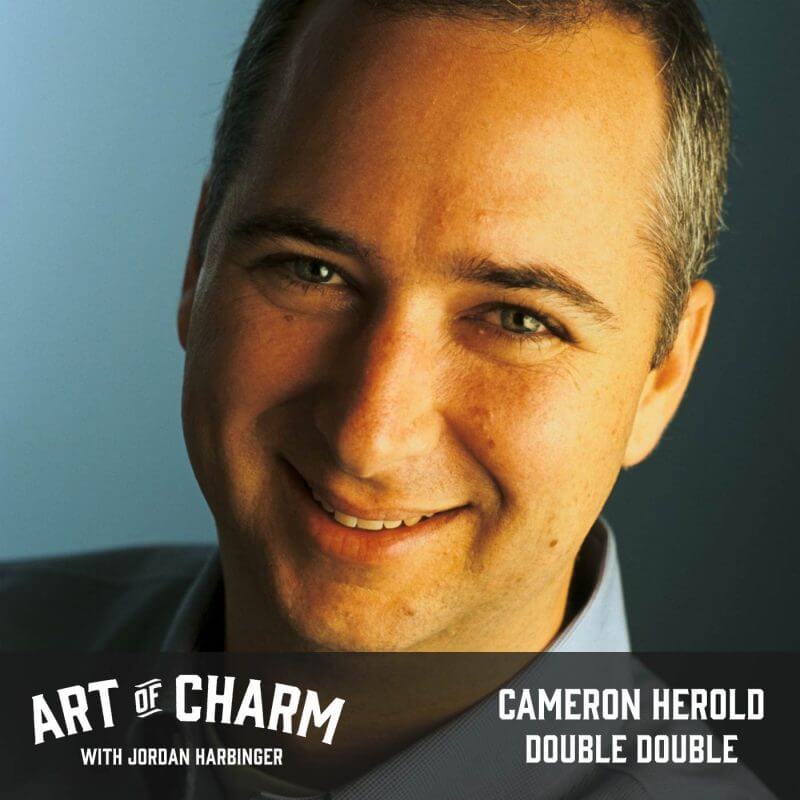Cameron Herold (@CameronHerold) tells us how we can double our revenue and profit in three years or less in his book Double Double.
The Cheat Sheet:
- What’s the real harm in a serial entrepreneur’s lack of focus?
- Sometimes, working backwards is the best way forward.
- What does R&D really stand for?
- Learn why you should work on your B team to make them A players and lose the C players.
- Focus your learning on what’s coming next.
- And so much more…
[aoc-subscribe]
On episode 481 of The Art of Charm, we talk to Cameron Herold, former COO of 1-800-GOT-JUNK? and the man responsible for bringing the company from two million dollars to a hundred and six million dollars in six years. He’s also the author of Double Double: How to Double Your Revenue and Profit in 3 Years or Less.
We’re going to ask him all about hiring, R&D (in this case, it doesn’t stand for research and development), how to build a great company and attract A-level talent, and we’ll discuss something called the entrepreneurship rollercoaster. Buckle up and enjoy the ride!
More About This Show
If you’re a serial entrepreneur with dozens of ideas constantly swirling around in your head, you may think you’re sitting on a multitude of gold mines just waiting to be explored. You’re probably not wrong, but if you’re not focused, you’re going to waste a lot of time and effort with less to show for your trouble than you might feel due.
Cameron Herold, author of Double Double: How to Double Your Revenue and Profit in 3 Years or Less, chooses a less eloquent metaphor than gold mines for how this lack of focus affects your end result (while recalling precious nuggets of another kind). “At the end of the day, we need to treat every business like it’s a toilet,” he says. “And if a person sits on more than one toilet, it gets kind of messy.”
Cameron counters this by working with serial entrepreneurs and getting them to look at each business as its own vision that needs to be treated and reverse engineered. He has their CEOs look three years into the future to see what they envision in these not-too-distant days ahead.
“They describe every aspect of their business,” says Cameron. “They describe the people, the culture, the meeting rhythms, they describe what they’re seeing, they describe each functional business area of their org chart as if it’s in its finished state. And they don’t talk about how it happened, but they describe what they see and what it feels like. And then we can figure out how to reverse engineer that.”
While it may be a difficult exercise at first, Cameron says it’s essential to have an eye on this future for anyone looking to experience growth — especially the rapid growth that makes doubling profits in those three years possible. He gives the example of Elon Musk’s foresight that brought about the creation of his Tesla Model S.
“The reason it’s a seven-seater,” says Cameron, “is he has five kids. So he thought, ‘If I’m going to build this amazing car three years from now, it better fit my family.’ And he didn’t decide to make the Prius a little bit bigger or a little bit faster; he leaned out and decided what he wanted, and then he figured out how to make it happen, how much money he needed, and how to build it within his core values. But he decided where he was going and then reverse-engineered that.”
But this doesn’t mean you should be ignoring the innovations that are going on around you, either. Where some might think of R&D as meaning “research and development,” it means “rip off and duplicate” in Cameron’s vernacular. “I try to look at what the most successful people on the planet have been doing,” he says, “and I just do what they’ve done.” Of course you want to create your own unique version of whatever it is you’re emulating (or ripping off), but why reinvent the wheel?
Cameron also stresses the importance of strategy toward the bigger picture over short-term gains that only seem to be better choices on the surface. When he was starting out, he chose to take the jobs that taught him more about the nuts and bolts of running a business and gave him access to meeting the most successful people — whereas he had friends who would opt for the jobs that paid more for entry-level employees. This was another way of leaning into the future and visualizing which road would get him closer to his destination.
In spite of having big dreams and goals, Cameron wasn’t always so driven. But he does have this to say about his lazy childhood: “What I realized by being lazy was that there were shortcuts. There was the path of least resistance to get things done. So I always found that the kids who were working hard and studying hard were the idiots because there was an easier way to get to the answers. So in business, it’s the same thing. There’s all kinds of hard ways to do stuff, but if millions of companies are spending millions of dollars with the smart people figuring out the best systems, why don’t I just take these best systems and put them in place, but kind of strip them down so they’re easy?”
Through trial and error, he learned that it’s important to do the critical few things versus the important many. For instance, when he was on the leadership team of College Pro Painters (the largest residential house painting company on the planet), Cameron saw how 40 people at the home office would recruit 800 franchisees, who would then recruit 8,000 painters — mostly college students — every season. This would produce 60 million dollars in revenue in four months, but as students would go back to school and rotate out, the company would have to rebuild the bulk of its workforce from scratch.
It was a monumental undertaking, but the company mastered the art of making it work by understanding what mission critical aspects of the business demand the resources of time and money, and other aspects that might seem important in the short term, but don’t warrant in-depth attention. As College Pro Painters’ founder would tell Cameron, “It’s about saying yes to the absolute right opportunities and saying no to the ones that just don’t seem a fit at the time.”
In other words, it’s being very careful about not getting bogged down in inconsequential frills that eat into your ROI (return on investment). Cameron tells us how College Pro Painters used exactly four pieces of marketing collateral. “The reality is, we only needed four, because the customers are never tired of your marketing. We get tired of our own marketing because we see it every day, but the customers don’t get tired of it.” Realizing this meant they could say no to constantly churning out new ideas for advertising — because they already had content that worked — and say yes to focusing on those critical few things that actually had an impact on increasing profit for the company.
So what are these critical few things? Ensuring that everyone in a company is on board with that company’s vision (and nurturing a culture that supports it) is first and foremost. Second is making sure you’ve got the right people — and this is where a lot of leaders fall short.
“You need to work really hard at getting rid of the wrong people,” says Cameron. “I think of people like horses, and I categorize them in three ways: your A players are your racehorses. Your B players are your workhorses. And your C players should go to the glue factory! We often spend too much time with our C players; we spend time with our underperformers, or we spend time with the people that are cultural cancers and try to get them back into shape. What we should do is get rid of them. We should be giving our time to our best people and to our B players and growing them instead of giving our time to our worst people.”
Cameron feels the same way about customers. Some people will never be pleased, no matter what you can do for them. Instead of succumbing to the myth that the customer is always right, understand that you can get rid of your most negative customers — the ones with unrealistic expectations — and better serve your core base by spending time fixing your products and services. If you can do this, “you don’t even need a customer service department,” says Cameron.
Another area that often gets neglected within a business is communication. While email may seem like the ideal way of keeping in touch and passing along memos in the 21st century, it also allows for potential miscommunication. “I’d have all your listeners write down this six-word sentence,” says Cameron. “I didn’t say you were beautiful. If you put the emphasis on each of the six words, it means six completely different things.” This is why Cameron stresses the importance of teaching people within your organization to communicate verbally, run proper meetings, and use video over depending 100 percent on email.
So we’re focusing on making sure everyone within our organization is aligned with the same vision. We’re recruiting and improving good staff while getting rid of the bad. We’re using formats of communication that minimize mixed signals and conflict that arise from miscommunication. What are we missing? Environment.
“Most often we need to get rid of the private offices,” says Cameron. “I’m not so worried about whether you have a Wii room or a foosball table or free icicles. The big things I want to get rid of are the blinds in the offices. I want to get rid of doors. I want to get rid of physical, private offices so everyone is connected. Everyone’s on the floor, working together, and everyone’s completely engaged. And that’s really where the core of culture comes from.”
Listen to this episode of The Art of Charm in its entirety to learn why you shouldn’t start your day with busy work (especially if it begins with an “e”), what you should do instead of hiring for attitude and training for skill, how Cameron created the number two best place to work in Canada, how teaching diverse generations to work together harnesses their symbiotic value, why Cameron doesn’t agree with the trendy “failure is good” sentiment, why we should be raising kids to be entrepreneurs (especially the ones who “experts” say should be medicated), the benefit of remembering rule number six, and lots more!
THANKS, CAMERON HEROLD!
If you enjoyed this session with Cameron Herold, let him know by clicking on the link below and sending him a quick shout out on Twitter:
Click here to thank Cameron Herold on Twitter!
Resources from this episode:
- Double Double: Double Double: How to Double Your Revenue and Profit in 3 Years or Less by Cameron Herold
- Let’s Raise Kids to Be Entrepreneurs (Cameron Herold’s TED Talk)
- Think and Grow Rich by Napoleon Hill
- Books by Jim Collins
You’ll also like:
On your phone? Click here to write us a well-deserved iTunes review and help us outrank the riffraff!




